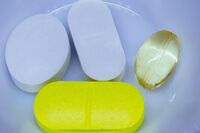Chemistry:Dok-1 Max
 | |
| Clinical data | |
|---|---|
| Pronunciation | Dok one Max |
| Trade names | Marion Biotech Dok-1 Max, others |
| AHFS/Drugs.com | Max.html Monograph |
| (verify) | |
Dok-1 Max is a type of cold medicine manufactured by Marion Biotech Pvt. Ltd.[1] Produced in India . It contains paracetamol, guaifenesin, and phenylephrine hydrochloride.[2]
Pharmacotherapeutic group
Analgesic antipyretic belongs to the group, international pharmacological code ATX N02BE51.[3]
Pharmacological properties
Pharmacokinetics
Paracetamol is absorbed in the gastrointestinal tract (GIT), and reaches the highest plasma concentration 10-60 minutes after ingestion.
Guaiphenesin is rapidly absorbed in the gastrointestinal tract (25-30 minutes after consumption). Metabolized in the liver. The half-life is 1 hour. It is excreted in the urine in the form of inactive metabolites.
Phenylephrine hydrochloride – after oral administration, the elimination process is slow. It is metabolized by monoamine oxidase (MAO) during passage through the intestinal wall and liver. Part of the dose is excreted unchanged in the urine.
Pharmacodynamics
Paracetamol in the drug is an analgesic that does not require habituation. In addition, paracetamol is an antipyretic and weak anti-inflammatory drug. The mechanism of action is associated with inhibiting prostaglandin synthesis and blocking cyclooxygenase enzyme (COX-1, COX-2) in the central nervous system, thermoregulation center and Hypothalamus affects pain receptors in the hypothalamus. and guaifenesin is an expectorant. Reduces the surface tension and viscosity properties of sputum, which facilitates the evacuation of sputum from the respiratory tract. Phenylephrine hydrochloride has a vasoconstrictive effect, reduces swelling and hyperemia of the mucous membranes of the upper respiratory tract and nasal sinuses.[3]
Instructions for use
- ORVI,
- Cough
- in inflammations of the nasal area
Method of administration and doses
Syrup:
- Adults over 12 years old 10 ml 3-4 times a day
- 6-12 years old 5 ml 3-4 times a day
- 2-6 years old 2.5 ml 3-4 times a day.[4]
Side effects
Observed in many cases:
- Headache
- Dizziness
- Rashes on the skin
- Nausea
- Note
- Epigastral pain in the area
Observed in few cases:
- Acute pancreatitis
- Midriaz
- Glaucoma
- Depression
- Trombotsitopeniya
- Leykopeniya
- Gipoglikemiya
- Dizuriya
When overdosed
- Diarrhea
- Bleeding from the stomach
- Psychomotor disorders
- Hypoglycemic coma
- Nephrotoxic conditions.[3]
Adverse effects
- Hypersensitivity to drug components
- Concomitant use of other paracetamol preservatives
- Hypothyroidism
- Arterial hypertension
- Ischemic heart disease
- Raynaud's syndrome
- Epilepsy
- Liver and kidney failure
- Bronchial asthma
- Hepatitis
- Pancreatitis
- Stomach and duodenal ulcer disease
- Diabetes
- Pregnancy and lactation period.[3]
The drug is produced in the form of tablets and syrup. Given without a doctor's prescription.[2] As of December 27, 2022, the drug was withdrawn from sale in all pharmacies in Uzbekistan.[5]
See also
References
- ↑ "Dok-1 Maks tabletki". https://quramax.uz/%D0%B4%D0%BE%D0%BA-1-%D0%BC%D0%B0%D0%BA%D1%81-%D1%82%D0%B0%D0%B1%D0%BB%D0%B5%D1%82%D0%BA%D0%B8/. Retrieved December 29, 2022.
- ↑ Jump up to: 2.0 2.1 "Dok-1 Maks". https://medu.uz/instruksiya/dok-1-maks/. Retrieved December 29, 2022.
- ↑ Jump up to: 3.0 3.1 3.2 3.3 "Dok-1 Maks (sirop)" (in ru). https://drugs.medelement.com/drug/%D0%B4%D0%BE%D0%BA-1-%D0%BC%D0%B0%D0%BA%D1%81-%D1%81%D0%B8%D1%80%D0%BE%D0%BF-%D0%B8%D0%BD%D1%81%D1%82%D1%80%D1%83%D0%BA%D1%86%D0%B8%D1%8F/507261371477650962?instruction_lang=RU. Retrieved December 29, 2022.
- ↑ "Dok-1" (in ru). https://apteka.uz/product/dok-1.
- ↑ "«Dok-1 Maks» dorisi tarkibida zaharli modda — etilenglikol topildi". https://www.gazeta.uz/oz/2022/12/27/ssv/. Retrieved December 29, 2022.

